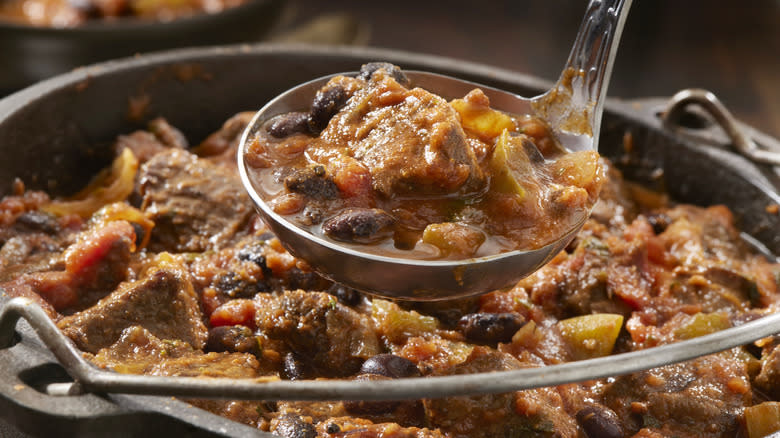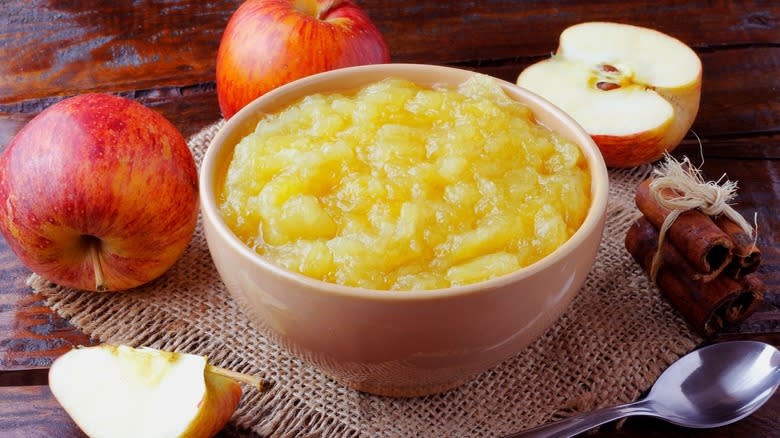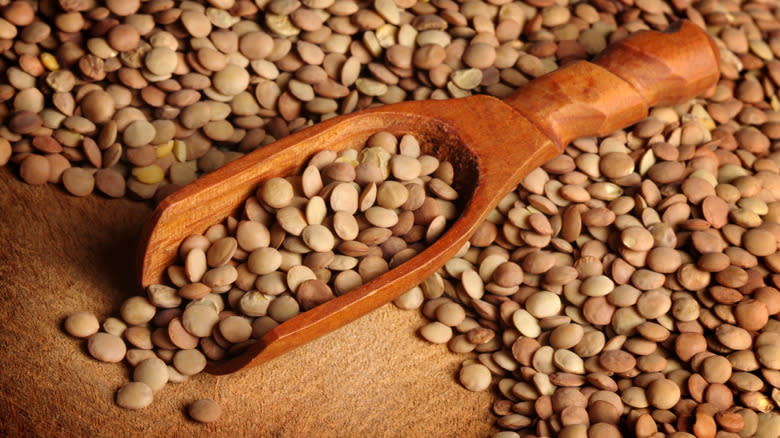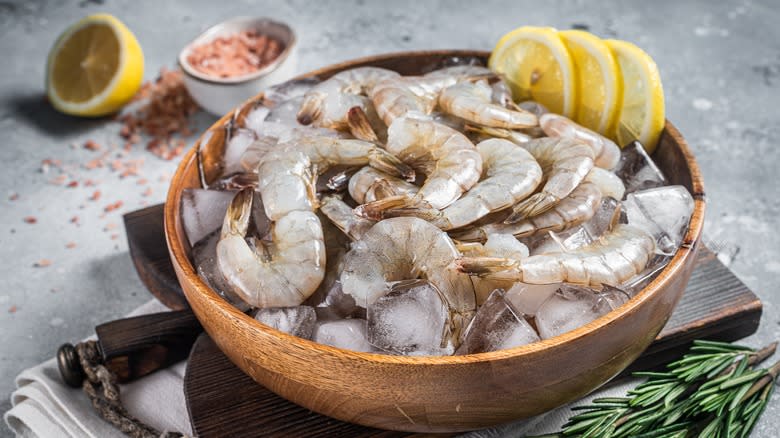14 Ingredient Swaps That Will Make Chili So Much Better

It's hard to improve a classic chili, but we're determined to find a way -- and swapping ingredients is a good place to start. There are hundreds of chili recipes out there, from slow cooker to Cincinnati, and these recipes are usually pretty standardized, with regional variations of the classic dish each having their own specific charm. We think, though, that some of these standardized recipes could do with a revamp, and by subbing some ingredients for others, you can bring out important flavor dimensions that give your chili more depth and dynamism.
Virtually every ingredient in chili can be swapped out, from its tomato sauce base to its chiles to the meat you use, and even the liquid you pour in to loosen everything. Certain swaps, like using soda instead of stock or wine instead of water, might be pretty out there, but they unlock new sweetness and acidity in your dish. Other swaps are simpler, like opting to use ancho chiles instead of jalapeños, but give a surprising amount of flavor quickly and easily. This is just the tip of the iceberg, though -- there are more ingredient swaps than you ever thought possible.
Read more: The 13 Best Steaks For Grilling
Swap Out Your Tomato Sauce For Bloody Mary Mix

Bloody Mary mix isn't just for your hair of the dog beverage, folks. Adding Bloody Mary mix to your chili will give it heat, tanginess, and saltiness in one go. Tomato sauce is, of course, the main ingredient in the mix and gives your chili that all-important savory base. The Tabasco or horseradish also added to the mix provides a fiery undertone and can replace the chiles normally added to your recipe. The lemon juice in Bloody Mary mix adds a hint of tartness that cuts through the savoriness of the tomatoes and the meat, and the Worcestershire sauce adds a host of complex flavors.
As Bloody Mary mix can be fairly salty, it's best to tread carefully with it. The last thing you want is to flood your chili with excess salt and make it inedible, so ensure that you add less salt elsewhere, or use water instead of bouillon or broth. Remember, too, to account for the other flavors in your Bloody Mary mix -- you don't want to add extra Worcestershire sauce, for example, if you already have some in the liquid.
Rather Than Worcestershire Sauce, Use Balsamic Vinegar

Worcestershire sauce is a classic component in chili. Just a few dashes of the sauce provide an intense umami flavor, along with a pop of acidity, saltiness, and a sweet undertone. While all of these elements work well in the dish, they can give it a distinctive, somewhat boring flavor -- instead, you can use balsamic vinegar to perk up chili in a unique way.
Balsamic vinegar has a lot of the flavor components that Worcestershire sauce does, but where the latter is more savory, the former gives more acidity. This acidity, though, is pretty useful. Vinegar is a vital component in chili, as it helps to cut through the dish's richness, brightening up what can be a fairly dense meal. Balsamic vinegar is especially well-suited for this purpose, as it has a fruitiness that means it isn't just blindly acidic but rather well-rounded and full. If you want to add more sweetness, try using balsamic glaze instead. A reduced combination of balsamic vinegar and sugar, balsamic glaze is way thicker and more intense, so just use a small amount.
Sub Your Stock For Soda

Some ingredient swaps truly blow your mind while also introducing you to a whole new world of flavor. This is definitely the case when you're swapping stock with soda, which will give your chili a unique flavor boost. Using soda instead of stock provides chili with acidity and sweetness. Naturally, this is the polar opposite to the saltiness of stock, but the flavor isn't overwhelming and instead gives chili a roundness. In fact, soda pairs excellently with red meat like beef, cutting through its richness with its sugary tang.
Soda also operates as the liquid component -- and if you're worried about your chili being too sweet, you can always cut it with a little water. If you're going to use soda, we'd recommend keeping it simple: Stick to Coca-Cola or Pepsi. While you can use Dr. Pepper, too, it's best to steer clear of fruitier drinks like orange-based sodas. We would also heavily advise that you use regular sodas and not diet versions. These sodas will give your chili a nasty artificial taste and destroy your hard work.
Avoid Ground Beef And Use Stew Meat

Ground beef is far and away the most common meat used in chili recipes, with its smaller size perfectly matching your beans and chopped vegetables and its deeply savory flavor providing richness. Ground meat isn't the only type you can use, though: Make your next chili with stew meat and thank us later. Stew meat comes in larger chunks, which become tender and break apart when simmered slowly. As they do, the beef flavor infuses through your chili, giving it a far richer, deeper flavor.
Stew meat also gives you a more satisfying mouthful with each bite: As the beef tenderizes and falls apart, you're left with manageable chunks that are bigger than ground beef pieces but still small enough to eat by the forkful. It's also cheap, so you don't have to worry about breaking the bank. Importantly, though, stew meat should be reserved for slow-cook chili recipes, not those that you're trying to make in a hurry. Because stew meat is fairly lean, if you don't let it cook for long enough, it'll remain tough and chewy.
For Extra Flavor, Use Ancho Chiles Instead Of Jalapeños

Chili isn't chili without chiles. These peppers give chili its necessary spice and warmth and cut through the denser notes of the meal with a pop of fire. Jalapeños are by far the most common chiles used in chili, where they add a vegetal brightness alongside their heat. Using jalapeños, though, can see you missing out on some depth, and if you want to give your brisket a deep, smoky flavor, use ancho chiles.
Ancho chiles may not give your chili loads of heat, but they provide a charred, almost barbecue-like flavor. These chiles are made by drying poblano peppers until they shrivel up and turn dark. This drying process gives them serious smokiness and intensifies their sweetness. Ancho chiles are fairly easy to find in stores, and they'll often come either in jarred or dried form. If they're jarred, using them is as simple as fishing them out, slicing them up, and throwing them into your chili. If you buy them in dried form, you'll need to either soak or steam them to soften them up, before adding them to your dish.
Instead Of Tomato Sauce, Use Ketchup

Tomato sauce is commonplace in chili recipes. In some chilis, it serves as the backbone of the dish, whereas in others, just a little is added to give the meal a sweeter, slightly tart flavor. There's an ingredient that adds that same tangy, sweet twist to chili, though, and it can be used instead of tomato sauce easily -- because it's made of tomatoes, too. Tomato ketchup is, for all intents and purposes, an amped-up version of tomato sauce or paste, and with its extra sugar, vinegar, and salt, it can amp up your chili, too.
Each element in ketchup helps to round out various aspects of the dish. The acidity from the tomatoes and vinegar helps to temper the relentless savoriness of the beef and beans, giving your chili a vibrancy that normal tomato sauce doesn't quite capture. The sugar also balances out the meatier flavors, while the ketchup's saltiness brings your spices to life. It's best not to use too much ketchup in your chili, though, as it can be surprisingly overwhelming, even in smaller quantities.
Skip The Pinch Of Sugar And Use Applesauce

Chili comes alive when you add sugar to it. It can seem like an odd ingredient, but sugar acts as both an activator and a balancer, intensifying the flavor of various components while contrasting your acidic tomatoes and meaty beef. Adding granulated white sugar, though, can introduce a harsh sweetness to your chili's flavor. A surprising ingredient that'll easily sweeten your chili without this happening is applesauce, which adds a mellow, gentle, slightly fruity sweetness that subtly brightens your recipe.
Applesauce also helps to thicken your chili slightly, giving it more body and a slightly smoother mouthfeel. If you don't have any applesauce, other purées can work just as well. Pumpkin purée can provide all of the textural benefits of applesauce and gives an even gentler sweetness while imbuing your chili with a vegetal flavor that complements the beans. If you need something more immediate, a squeeze of honey or maple syrup can also deliver a floral sweetness.
Rather Than A Pinch Of Salt, Use A Dash Of Fish Sauce

Chili is nothing without salt. The seasoning acts to awaken pretty much every ingredient in the dish and intensifies its savoriness. While it enters your pot as a component of a lot of your ingredients, like your stock and Worcestershire sauce, you'll still likely want to finish your chili off with a pinch or two of salt to bring everything together. There's another ingredient that'll take your chili up a notch which you can add at the end of the cooking process, too -- and that's fish sauce.
Fish sauce is usually reserved for Thai, Vietnamese, and other styles of Asian cuisine, but it's equally at home in this Tex-Mex dish. This sauce is made from fermented fish, and its preparation process develops an exceptionally rich umami flavor and a strong saltiness. The combination of these two things gives your chili immediate intensity.
When adding fish sauce, you should be pretty careful. Even a dash or two too much can leave your chili tasting fishy and briny, instead of giving it the subtle umami you're looking for. You should also make sure to simmer your fish sauce in your chili for a few minutes before serving it, to reduce any unpleasant fishiness.
Instead Of Meat, Use Lentils

Using lentils instead of meat in chili is an ingredient swap that vegetarians and vegans will be familiar with -- but meat-eaters shouldn't write this one off, either. Like ground beef, lentils have a spoonable consistency that works perfectly for chili. These tiny pulses also have a firmness and a dense, ever-so-slightly meaty flavor. While you'll definitely know that they're not made of meat, when they're seasoned correctly and you're using other umami-rich ingredients, you'll barely be able to tell the difference.
Lentils also have the added benefit of staying edible in dried or canned form in your pantry for months, meaning they can be used in your chili in a pinch. While some lentils need soaking to be edible, others can soften and cook in your pot in as little as 20 to 30 minutes. It's best to go for brown or green lentils in chili, instead of red ones: Not only do the former lentils have the right color profile to replace beef, but their gentler flavor means they're more receptive to savory seasonings. To swap them for beef, just substitute the same weight or quantity of lentils. Bear in mind, however, that if you're adding dried lentils, they'll get larger and take up more space.
Forget Water — Use Red Wine Instead

All chili recipes contain some form of liquid to loosen your ingredients and turn the dish from a dry, lumpy mash of components to a smooth, spoonable stew. If you're using water, though, you're missing out. Your chili will taste even better with red wine, which will help to add wild layers of flavor and depth to your dish. Red wine is a perfect pairing with ground beef and tomatoes and helps to round out your beef's flavor, giving it a fruity, mellow undertone and intensifying its savoriness. Red wine also gives your chili a deep color, which adds to its overall appeal (hey, we eat with our eyes first, guys).
You can use as much or as little red wine as you like. If you want to make an ultra-intense chili, replace all your water with red wine -- don't worry about it becoming boozy, as the alcohol will cook off. If you'd prefer to keep things a little more subtle, cut your red wine with some water and mix it in. Red wine isn't the only alcohol you can use as a water replacement. White wine and beer can also work as substitutes, with the former bringing a crisp floral edge and the latter giving your chili a moreish maltiness.
Swap Cilantro For Basil

Cilantro is, for most people, a must in chili. Whether mixed into your stew or sprinkled on top as a garnish, it adds an all-important pop of herbal flavor and flecks of wholesome green that cut through the brownness of the dish. Cilantro's not the only herb you can use, though. Basil has a sweeter, fruitier flavor than most herbs but also has that delicious pepperiness that makes cilantro stand out.
In fact, Ina Garten uses basil in her chicken chili, and the herb's slightly more delicate flavor is a natural fit for the lighter taste of chicken meat. However, there's no reason why you can't use it in beef chili, too. As with cilantro, you'll want to be careful with how much basil you use, as too much of it can make your chili taste a little funky and overly sweet.
If you don't have basil, there are other herbs you can use, too. Our next favorite is parsley, which gives a slightly more subtle pepperiness but still has that bright flavor you want from your herbs. Chopped chives are also an awesome choice to finish your chili, especially on top of a dollop of sour cream.
Sub Your Beans For Sweet Potato

It might seem like replacing your beans with something else in chili is a bad move. After all, this is one of the standard ingredients in chili, and arguably the thing that makes it most iconic -- and other than replacing your regular beans with, well, other types of beans, how can you replicate them? With sweet potatoes. Sweet potatoes may seem like a strange choice, but they offer the same sweetness and carby, satisfying, soft bite that beans do. As they're slightly brighter and sweeter than most beans, they help flavor the rest of your chili, giving it a lighter taste.
Sweet potatoes pair excellently with ground beef, and they can be chopped to whatever size you need, meaning they slot into your chili seamlessly. Their vibrant orange color also gives your chili a more exciting look, cutting through the incessant brownness with sunny, bright pops of vegetable. When substituting beans for sweet potatoes, just be aware of their cooking times. Like beans, they tend to soften pretty quickly when simmered, and if you're not careful they'll turn to mush in no time. Cook your sweet potato chunks until fork-tender and then pull your pot off the heat.
Instead Of Beef, Use Seafood

Most chilis are made with beef, but its relentless savory flavor can get repetitive after a while. So if you want to try something new, throw in some seafood. Seafood most definitely belongs in chili and gives your meal a brighter sense of savoriness, making the dish taste lighter with barely any effort. The best part is that you don't actually have to do that much work to add seafood into your chili, either: Most kinds of seafood go well with a tomato-based broth and pair smoothly with chiles, bell peppers, onions, and seasonings like Worcestershire sauce, all classic elements of this dish.
Importantly, however, not all types of seafood are the same, and the kind you choose will alter your chili's flavor significantly. Shrimp or whitefish will have a delicate flavor presence in your chili, whereas bolder seafood like mussels or oily fish will give your chili more of a sea-infused taste. Although you don't necessarily need to swap any other ingredients when making seafood chili, bear in mind that certain flavor elements will work better than others. Cumin, for example, may not pair well with gentler seafood flavors, and instead of using red wine in your broth, you might want to go with white wine, which will highlight the protein's crispness.
Rather Than Stock, Use Coffee

Stock acts as a bed of flavor in chili recipes, giving your other ingredients an undertone that highlights all of their individual tastes and ties everything together. However, the taste of stock can be weirdly pervasive and make your chili seem one-note. That's why you should use coffee instead. While it's probably an ingredient you never thought to put in your chili, that's no reason not to -- and the flavor benefits outweigh any weirdness.
Coffee and coffee grounds in chili act as an intensifier, bringing all your other flavors to life and adding a smoky, earthy undertone. It goes especially well with classic chili spices like cumin, cayenne pepper, and paprika. Coffee also has a gentle sweetness that brightens up chili, which can be brought out further by adding sugar into the mix.
It's worth remembering, though, that caffeine doesn't cook off like alcohol does, so if you're adding loads of coffee to chili, you should be prepared to be pretty alert afterward. There's an easy fix for this, though: Use decaf coffee. You'll get all the flavor and none of the jitters.
Read the original article on Daily Meal

